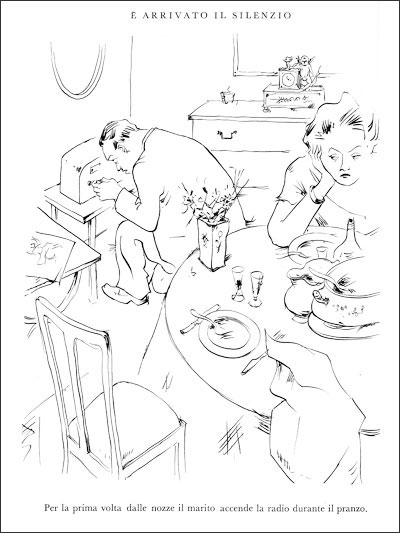Dinnertime – 60 years ago
The drawing below was made by Giuseppe Novello (1897–1988), a noted Italian cartoonist of times past that you most likely aren’t acquainted with. In his long career he used the medium of the newspaper cartoon to dissect the daily life realities of middle class society, with all its little joys and sorrows, its hypocrisies and hardships. Novello did this with a piercing perception, which one could call ruthless if it weren’t for its deep underlying humanity. I am fortunate to own the set of his works, and you can read about them at http://www.nzeldes.com/Miscellany/Novello.htm.
THE SILENCE HAS ARRIVED

.
The poignant sketch before you, from the 1950s, shows how the husband turns on the radio during dinner for the first time. This is sad enough, but the real skill of the artist is seen in the brutally perceptive main caption: THE SILENCE HAS ARRIVED. The radio was the opposite of silent, providing – like television soon after – an unending stream of sound and commentary; yet it represents the arrival of a silence between the disenchanted husband and wife.
The family in the drawing would be lucky to have a landline telephone, and could not have dreamed of the smartphones we all use today. But the situation seen here is very relevant to our present time.
Dinnertime – today
You’ve seen it, as have we all: people are sitting at the dinner table, at home or in a restaurant, and they play with their phones. Ten years ago they’d only talk on the phone: their cellphone (not yet smart) would ring, and they’d answer the call, apologizing with a quick “I gotta take this”, or not even bothering with that perfunctory acknowledgment of the rudeness involved. Today the actual call is unnecessary: people communicate during the meal on WhatsApp, SMS, or any of their social media channels; or they just scan the news, their Facebook feed, YouTube, and so on.
You’ve seen it, and you’ve probably done it yourself.
The similarities and the differences
The radio in the 1950s vignette and the smartphone today have the same effect: they come at the expense of human interaction. Our brain can’t multitask, and whether you’re listening to the radio, or playing with your iPhone, the result is the same: you ignore your fellow diners, be they spouse, family, or friends. This is rude, annoying, and anti-social; the end result is that we lose part of our humanity.
There is, however, a difference. The situation in the cartoon results from a faltering relationship between the participants; the husband, at least, is bored by his wife, and the radio fill this gap. But today we use our handhelds not because we dislike our friends; we do it because the devices intrude on our attention, addict us with their endless stream of information overload and easy thrills. In fact, where the husband’s preference for the radio hurts his wife (just look at her face), the use of smartphones in company is a seemingly victimless crime: everyone at the table will do it, and nobody will complain. Much of the use revolves around Facebook and similar channels – so you could argue that it isn’t even anti-social. The only victim is real-life social interaction, and who needs that when we have a world of social media at our fingertips?
Which is dead wrong: we were evolved to interact with our immediate family and friends, not with electronic devices. Smartphones can be fun – I love mine – but not as a replacement for a good dinner conversation.
What we can do about this
We can stop doing it, that’s what. The damage this habit carries is slow and insidious, but is definitely real. You should avoid using your mobile device during meals. If you are a parent, you should forbid your kids to do it too – and lead by example, of course.
These days we read more and more about people finally “getting it”, and imposing various degrees of “Digital Detox” on themselves. There are complications to doing it, but meal times are the easiest part. They are also, since the time we tamed fire and probably before that, a key social ritual for humans everywhere. Don’t let your device destroy it!
Related Posts
What Can We Do About our Teens’ Smartphone Addiction?


What you may be missing here (and I would suggest that you are) is the revolution that is at hand. Men and women get married to one another without being intellectually compatible. In other words, they fall in love with the emotion of being in love and then spend their entire passionate lives doing separate things. Technology has brought to light that more can be discussed at the dinner table than weather, and that bringing to light seems to have drawn the man to another lover. “I do not like conversating with the other person” is the problem at hand, not the distraction of technology or the rudeness of letting oneself be destracted by technology.
You should do research on a man named Ray Kurzweil and read the source code for dictionary.com. The two are related to your blog post. : )